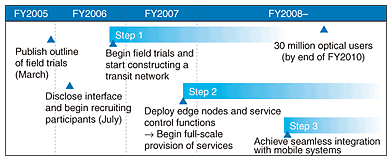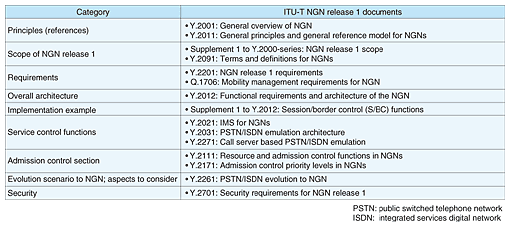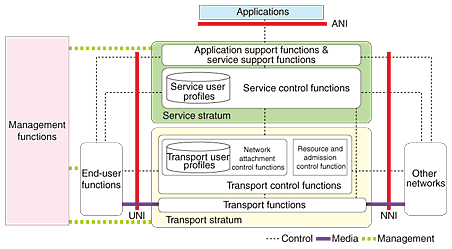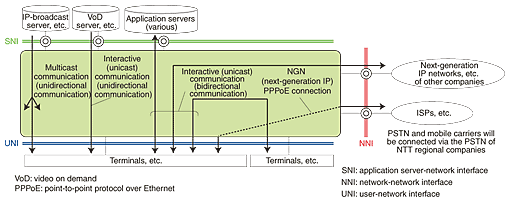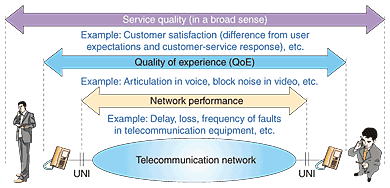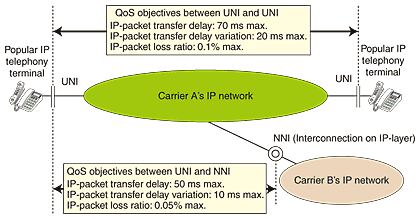 |
|||||||||||||||||||||||||
|
|
|||||||||||||||||||||||||
|
Special Feature: NGN Communication Styles and Support Technologies Vol. 5, No. 6, pp. 6–13, June 2007. https://doi.org/10.53829/ntr200706sf1 Overview of the Next Generation NetworkAbstractNTT is a world leader in building a next generation network (NGN) based on optical communications and full IP (Internet protocol) connectivity. This article overviews NGN features (high quality, security, reliability, and openness), discusses standardization trends, presents interface specifications for field trials, and describes quality of service (QoS) specifications.
1. Toward the next generation networkInternational standardization of the next generation network (NGN) is now being actively discussed in ITU-T (International Telecommunication Union Telecommunication Standardization Sector) and other organizations, and carriers throughout the world are following various plans toward NGN deployment. As part of this global movement, NTT announced in November 2004 its commitment to building an NGN based on optical communications and full IP (Internet protocol) connectivity as an important element of the NTT Group's Medium-Term Management Strategy. Since then, NTT has been working to expand the use of optical fiber. In recent years, the demand for high-speed and dependable broadband access to Internet services by optical fiber has risen considerably. The number of broadband subscribers as of the end of September 2006 was reported by the Ministry of Internal Affairs and Communications (MIC) to be 25,040,000. Among those, the number receiving optical-access services was 7,150,000, which represented a dramatic 79.6% increase over the previous year. The use of IP telephony services also showed a significant increase. Against this background, NTT has undertaken the construction of an NGN that combines the great features of the fixed telephone network cultivated over many years (e.g., high quality, reliability, and stability) with the merits of IP networks (e.g., support for diverse services and economy of scale). And with an eye to connecting to other carriers' networks and enabling players in diverse businesses and industries to create new services and value, NTT is working to achieve openness and connectivity in the NGN while also taking into account the need for seamless connections with future mobile systems. 2. Features of the NGNNTT's NGN has a layered structure model to support technical innovations and the development of high-speed, diverse services. Its architecture conforms to NGN standard specifications. Its interfaces conform to international standards (e.g., ITU-T recommendations and IETF RFCs) and domestic standards (TTC standards and TTC technical reports). These standards are followed to enable various players such as application service providers and video distributors to offer diverse application services and to provide an open network that ensures mutual connectivity with other IP networks including those of Internet service providers (ISPs). The following provides a brief description of the features that NTT's NGN aims to provide. (1) High quality The NGN aims to provide high-quality broadband communications by controlling the quality of service (QoS) on an end-to-end basis. The idea is to provide multiple QoS classes having different features and to enable the appropriate QoS class to be selected when an application is provided. For example, a high-priority QoS class would be guaranteed the bandwidth necessary to enable the user to enjoy high-quality audio or HDTV-class video (HDTV: high-definition television) without having to worry about QoS degradation during a session. (2) Security The NGN will include functions for monitoring signal traffic and data traffic, for checking telephone numbers, IP addresses, and other information identifying originators (as a countermeasure against spoofing), and for blocking unusual traffic at the entrance and exit nodes to the network. (3) Reliability To improve reliability, efforts will be made to make each and every telecommunications device in the NGN highly reliable. And to maintain high reliability while ensuring essential communications, network-oriented countermeasures will be taken. These will include the provision of redundant configurations for communication circuits and equipment and traffic-control procedures for responding to traffic congestion in particular areas. (4) Openness NTT aims for an open NGN to enable various players to use the network and provide diverse services and to enable mutual connectivity with other carriers that are also working to provide high-quality communications services. For this purpose, NTT disclosed the interface specifications for upcoming field trials in July 2006 (described in detail later) [1]. 3. Roadmap for building the NGNNTT's plan for building the NGN has three steps, as shown in Fig. 1.
Step 1: In the second half of FY2006, build the transit network for the NGN and commence field trials*1. Showrooms were opened in Tokyo and Osaka in December 2006 and trials began. Step 2: In the second half of FY2007, deploy edge nodes for optical-subscriber lines and service control functions and begin to provide NGN services on a full scale. Step 3: Achieve seamless integration with the mobile network in conjunction with the conversion of mobile voice signals to IP and the deployment of Super 3G*2 mobile services in the mobile network. 4. Commencement of field trialsThe NGN field trials, which began in December 2006, aim to test various functions and technologies. These include end-to-end QoS control functions that perform dynamic control for a wide range of communications from voice to HDTV-class video; IP multicast functions for large-scale delivery of HDTV class video; security functions for preventing unauthorized access and for providing reliable, safe, and convenient services; multiplexing and integration technologies for integrating diverse services in an economical and efficient manner to achieve service convergence; functions for linking fixed and mobile services; and open connectivity functions for linking applications. The field trials are scheduled to run for about one year in the Tokyo and Osaka areas. The first period (starting in December 2006) will target visitors to NGN showrooms*3, the second period (starting in January 2007) will expand to NTT Group employees in the same areas, and the third period (starting in April 2007) will target general customers in those areas. Prior to the launch of these field trials, NTT released interface specifications [1] between the networks involved in the trials, between user terminals and the network, and between application servers and the network. NTT also invited many parties from a wide variety of fields to participate, including home information and appliance vendors, service providers, and other carriers. The following introduces trends in NGN standardization, interface specifications for the field trials, and QoS specifications.
5. Standardization trends of NGNStandardization of the NGN began at the NGN Workshop held by ITU-T in July 2003 (Geneva). Following this, Recommendation Y.2001 "General overview of NGN" and Recommendation Y.2011 "General principles and general reference model for Next Generation Networks" were approved in June 2004, and 13 documents prescribing the outline section of NGN release 1 began the approval procedure for becoming recommendations at the SG13 meeting held in July 2006 (Table 1).
A characteristic feature of the NGN specified by Supplement 1 to Y.2000-series "NGN release 1 scope" and Y.2201 "NGN release 1 requirements" is the use of the IP Multimedia Subsystem (IMS) established by the 3rd Generation Partnership Project (3GPP). The IMS is being adopted by the Internet Engineering Task Force (IETF) as a base protocol for the session initiation protocol (SIP) specified by a series of RFCs (requests for comments), including RFC3261. The IMS specifications add security and quality-control requirements and specify how they can be combined with the above SIP-related RFC documents that are now being standardized in the IETF. Moreover, at the TISPAN (Telecommunications and Internet converged Services and Protocols for Advanced Networking) project launched by the European Telecommunications Standards Institute (ETSI), about 60 documents for the NGN release 1 specifications series centered on IMS provisions for the fixed network had been nearly completed as of the February 2006 meeting of the project. Meanwhile, in Japan, an NGN Architecture Experts Committee was established in April 2005 at the Telecommunication Technology Committee (TTC). To date, several standards and technical reports regarding the NGN and interface specifications have been issued by TTC. These include TR-1014 "Overview of the NGN Architecture" and TR-9024 "Technical Report on Basic Call Interface for SIP Terminals Connecting with NGN" (Table 2).
6. NGN architecture in ITU-TThe architecture for the NGN is prescribed in ITU-T Recommendation Y.2012 "Functional requirements and architecture of the NGN". The NGN consists of four function groups and two types of user profiles (Fig. 2). Transport functions transfer multimedia streams over the IP network. Transport control functions allocate IP addresses, perform authentication tasks, and enable control functions such as resource admission for guaranteeing IP-layer QoS to be used from service components. Service control functions (such as IMS) and application support functions & service support functions provide support functions such as presence management.
Two types of user profiles are specified based on how user information used by the service control function group and transport control function group is applied and how it relates to the functions. One of these is the transport user profile, which is referred to by the transport control function group. This profile includes information such as user authentication data and the bandwidth that the user may obtain when connecting to the access network. The other is the service user profile used by the service control function group. This profile includes information such as what services the user is allowed to use and how many simultaneous connections may be made. ITU-T Recommendation Y.2012 calls for three types of interfaces: (i) the user-network interface (UNI), which is the connection point with end-user functions; (ii) the network-network interface (NNI), which is the connection point with other networks; and (iii) the application-network interface (ANI), which is the connection point with application functions. For ANI, the function model that is currently provided is only an example, but a specific model will be provided in the future. 7. Field trial network functions and interface specificationsThe field trials will support the following four types of communication functions to control the bandwidth and QoS corresponding to different QoS classes assuming a range of applications from voice calls to HDTV class video communications (Fig. 3 and Table 3).
(1) Interactive (unicast) communication (bidirectional communication) functions For communication services such as IP telephony and video telephony services. TTC technical reports TR-9024, TR-9025, and others are referred to as interface specifications. (2) Interactive (unicast) communication (unidirectional communication) functions For communication services such as video-on-demand service. (3) Multicast communication (unidirectional communication) functions For communication services such as video delivery (IP broadcast) service. (4) PPPoE connection functions For communication services such as ISP connection service. Interface specifications [1] for the field trials conform to ITU-T recommendations and specify the interconnection between the NGN and terminal equipment (UNI) and between the NGN and telecommunication carriers (NNI). Interface specifications between the NGN and application-server equipment (SNI: server-network interface) are being added and released. Since the ANI now being discussed at ITU-T currently consists of only a function model example, as mentioned above, NTT has proposed SNI as a specification that not only fully covers ANI but also expands upon it. With an eye toward interactive (unicast) communication functions, multicast communication functions, and other functions that have just begun to be discussed at ITU-T and to enable application providers to make use of NGN functions as a resource and to enable open services to be provided, NTT is providing flexible interface specifications covering the span from physical layer connections to upper-layer connections. As for NGN protocol, connection control will be performed in accordance with TTC technical reports TR-1014, TR-9022, TR-9024, and TR-9025, and related protocol specifications. 8. QoS specifications in the NGNQuality is an important concept in NGN construction. However, the word "quality" can have various meanings. For example, quality can be used in relation to speech quality in telephone calls or picture quality in video delivery services. It may also be used in connection with communication services to describe, for example, the degree to which telecommunication equipment operates correctly without faults and the response that a customer receives from a service provider when applying for a service (Fig. 4). Of these various meanings, NTT has focused especially on quality of service (QoS) on the IP layer in the NGN. Our platform will provide many diverse services by providing multiple QoS classes with different features.
Standards for QoS in the NGN are now being discussed at ITU-T and ETSI/TISPAN, where NGN standards are being studied [2]–[5]. NTT refers to these standardization trends in establishing interface specifications [1] for its NGN field trials. It has specified four QoS classes and released QoS objectives for each class (Fig. 4). The parameters used to specify each QoS class are IP-packet transfer delay, IP-packet transfer delay variation, and IP-packet loss ratio between UNI, NNI, and SNI reference points (these parameters are specified by ITU-T [2]). Specifying QoS between reference points in this way clarifies the QoS provided by the NGN in terms of network performance. In an NGN, the QoS class required by a service (e.g., IP telephony, video delivery, or data communications) can be negotiated between the network and terminal/server. This makes it possible to provide services in accordance with stipulated QoS values for each QoS class. The above mechanism is not found in a best-effort network, which does not guarantee QoS. The features of these four QoS classes and ways of applying them are given below.
The highest-priority class EF (expedited forwarding)) gives IP packets the highest priority in the network. It features a short delay and small delay variation applicable to bidirectional realtime communication services such as IP telephony and video telephony. The high-priority class (high AF (assured forwarding)) gives IP packets the next-to-highest priority in the network. Featuring a relatively short delay and small delay variation, it is applicable to unidirectional communication services such as video delivery and video-on-demand. The priority class (low AF (assured forwarding)) gives packets priority over best-effort class and is used to achieve stable data communications. The best-effort class does not specify QoS objectives. It has the lowest priority in the network. In NTT's NGN, preparing multiple QoS classes with different features in the above way makes it possible to simultaneously provide multiple services with different requirements on the same network. 9. QoS regulations and allocation for IP telephonyAmong the various types of services to be provided by the NGN, the QoS regulations for IP telephony using 0AB-J phone numbers in Japan are clearly dictated by law [6]. These QoS regulations, however, raise some issues. For example, they do not clearly specify the QoS allocation between the network and terminal or the allocation for interconnections between carriers. For this reason, the Next Generation IP Network Promotion Forum [7] has been investigating new QoS regulations since January 2006. These are shown in Fig. 5. In NTT's NGN, the plan is to provide IP telephony services using 0AB-J phone numbers by means of the highest-priority class. The QoS objectives for highest-priority class conform to these new IP telephony QoS regulations. The new IP telephony QoS regulations under study at the Forum are distinguished by two points: (1) They clarify QoS objectives in telecommunica-tions networks (UNI-UNI) by assuming a popular IP telephony terminal. (2) They present the concept behind QoS allocation in telecommunications networks and clarify the QoS objectives for UNI-NNI when carriers interconnect. These clarifications establish the QoS objectives that individual telecommunication carriers must satisfy when providing IP telephony services in the NGN. (See [8] for details.)
10. Future plansNTT plans to conduct field trials in future to evaluate platform technologies and technical specifications toward the building of a genuine, full-scale next-generation network. References
|
|||||||||||||||||||||||||








